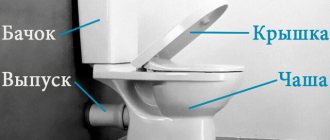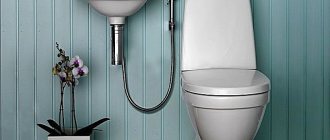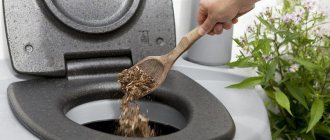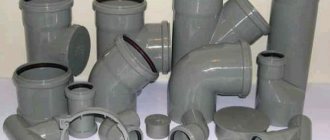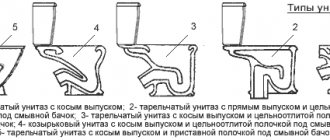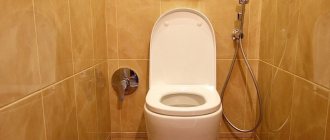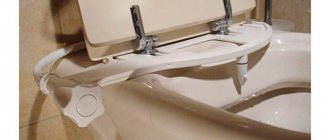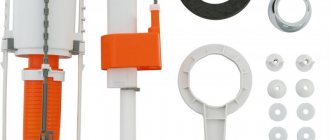In a typical apartment it is difficult to find space for additional amenities. The small bathroom only fits a toilet. But small dimensions are not a reason to refuse to improve your home.
Can't install a bidet? It will be fully replaced by a hygienic shower for the toilet, which takes up a minimum of space and performs the same functions as the familiar hygienic device. Its structure, design features and existing varieties will be discussed in our article.
We will also look at the intricacies of installing various types of hygienic showers, consider the main advantages and list the best manufacturers present on the plumbing market.
Hygienic shower design
Visually, a shower for performing personal hygiene procedures is almost no different from a regular shower.
Both the device and the other consist of the following parts:
- mixer;
- flexible hose;
- watering can.
There are still differences and they are due to the purpose of the device. Since the head of a hygienic shower should not produce a scattered stream, but a stream focused in one direction and preferably without splashes, it is significantly smaller than that of a conventional shower.
The faucets of some representatives of this special category of showers are equipped with a thermostat, which is very convenient because... There is no need to select the temperature - it is regulated automatically.
The thermostat is designed to mix water passed through the mixer to such a temperature that a person feels comfortable. A one-time adjustment after installing a hygienic shower in the toilet is enough and the thermostat will constantly maintain the set temperature.
The presence of this element will protect against burns, and if there is no hot water in the system, then the unpleasant sensations from this will be minimized.
The toilet, with a hygienic shower connected to it, will acquire new functionality, and a modest-sized bathroom will become much more convenient. This shower can be used not only for its intended purpose, but can also be used to wash shoes, a child’s potty, or a cat’s litter box.
While a regular shower has 2 outlets - for a flexible hose and a spout - a hygienic shower for a toilet simply does not need a second one.
Another feature is that even if the mixer is turned on, water will not flow from it until a special button is pressed, with which the flow is controlled. The jet pressure is adjusted using the mixer lever.
An alternative or a pointless replacement?
In terms of functionality, a concealed hygienic shower is an alternative to a bidet, but in a smaller version.
If we delve into the technical characteristics of the plumbing and consider the layout of the room, then installing a bidet requires a certain space in the room and a distance between the bathroom, which is not always enough.
Such a concealed shower is actively used in hospitals and hotels, where, according to established standards, such plumbing must be located.
The device is small in size and mounted on the wall, so valuable space is not used for a large item. This is the distinguishing feature of a hygienic shower from a bidet.
Important!
In any case, it is much easier to install a faucet connected to the toilet or sink than to buy a separate plumbing fixture. And the cost of these two items will differ radically.
Main types of devices
It is important to know the advantages of such a solution to the problem of keeping your body clean, such as installing a wall-hung or floor-mounted toilet with a hygienic shower.
There are usually 5 main arguments:
- simple installation, carried out in several ways;
- saving space in a small room;
- versatility;
- reasonable price;
- Ease of use.
The concept of a hygienic shower includes plumbing equipment that is completely different in appearance. According to design, there are 4 types of these devices for personal hygiene.
Option #1 – shower toilet
This is equipment of a special design, in which nozzles are built into the body. The control unit is built into the drain tank, which slightly increases its dimensions.
Plumbing fixtures of this type are both floor-mounted and wall-mounted. Manufacturers, in the process of improving their products, are constantly adding new ones to the list of available functions.
We recommend that you familiarize yourself with the models of bidet toilet attachments available on the market. This information is discussed in detail in our other article.
The most popular is a wall-hung toilet complemented by a bidet function. It is more convenient and better in terms of aesthetics because... its tank is masked by a plasterboard wall
Option #2 – bidet lid
A bidet lid can be a rather convenient mobile addition to an old toilet. The control unit built into the lid can turn on the function of heating water to a comfortable temperature, drying, and softly lowering the seat.
Although in appearance this special cover resembles a traditional seat, structurally it is very different from it. Installing this element completely transforms the toilet; it acquires all the characteristics of a bidet
An interesting solution is electronic bidet covers for toilets. This is luxury sanitary ware produced by well-known brands. Such devices are more functional and comfortable to use, but their price tag is higher than conventional ones.
Option #3 – wall-mounted structure
The option of a hygienic shower mounted on the wall is quite convenient to use. A long flexible hose with a compact watering can is placed near the toilet. They install it to the water supply pipes, which means additional construction work.
A good alternative to a shower built into the toilet is an addition such as a shower placed nearby on the wall
Option #4 – shower connected under the sink
To implement this option, you need to place a sink next to the toilet. The watering can and flexible hose are attached to a specially designed mixer with three outlets. For a separate bathroom, a miniature corner sink is enough.
When you turn the faucet handle, the stream from the spout flows into the sink. To make water flow from the shower, you need to press the button on the shower head.
The last option for a hygienic shower is the most profitable, based on the cost of the device itself and its installation. Its advantage is that you don’t have to worry about the water being too hot - its temperature can be adjusted to a comfortable level above the sink.
If you absent-mindedly do not close the tap, the water will flow into the sink, which will prevent your neighbors from flooding.
Advantages and disadvantages
In addition, a hygienic shower copes well with the problem of hygiene in any restroom, which also cannot but please the happy owners of such a unit. There is such a design as a “bidet”. A hygienic shower is an analogue of just such a technique, however, it is considered a more budget-friendly and simpler option. You can also purchase and install it yourself, without involving third-party specialists.
Although such a shower operates on a system similar to that used in a regular bathroom, it is still somewhat different. For example, a hygienic toilet shower uses a special valve to prevent water from leaking when the shower is not in use.
No matter how many advantages this design has, it, like everything else, also has its certain disadvantages. So, for example, even though such a shower uses a special valve , water still begins to leak sooner or later. This is a significant drawback for such a design. If you do not stop leaks in time, which can leave marks on the wall, you will very soon have to think about repairs.
Types of faucets for hygienic showers
This element of a hygienic shower, according to its design, comes in three types - valve, lever and with a thermostat.
The first is more common and differs in that the water volume is controlled through a valve. It is installed when connecting a hygienic shower to a sanitary cabinet. Thus, it is inconvenient to manually regulate the water temperature; an additional thermostat connection will be required.
A lever mixer is more convenient to use. It works well without additional equipment, so installation is easier. The designers assigned the lever the role of regulating water pressure and temperature. It's easy to manage all this with its help.
The photo shows a single lever chrome faucet. When installing, do not connect a long hose to it. It will interfere with temperature regulation
To constantly maintain the optimal temperature and pressure of the water jet for a particular person or all residents of the apartment, a thermostat mixer is more suitable than others. Its operation is not affected by any pressure surges in the system. The disadvantage is the high cost of the device.
Preparing for installation
Selecting location and installation height
You need to focus on height and body position in a sitting position. The arithmetic average of these two values will give the approximate height. How can you define it differently - install a sink and place objects under it until the position becomes comfortable for the reader.
Tools and materials
You will need:
- wrench;
- mount;
- hammer;
- sledgehammer;
- sealed film;
- roulette;
- drill;
- perforator;
- soldering iron;
- level.
Manufacturers of the best hygienic showers
This type of plumbing fixtures is widely represented on the market. When choosing, preference should be given to companies with a well-known name. There are not very many manufacturers producing high-quality products.
The following brands are ahead:
- Hansgrohe;
- Damixa;
- Grohe;
- Geberit.
Mixers manufactured at the enterprises of these companies are of excellent quality, easy to use, but their price is appropriate. Savings are still inappropriate in this case. A device purchased for little money will not last long, but a high-quality, but expensive product will justify the investment in it with decades of trouble-free operation.
We recommend that you familiarize yourself with the rating of the best hygienic shower models, compiled based on reviews from real users.
To avoid purchasing a fake, you need to check for a quality certificate. An original hygienic shower can be made of brass, stainless steel or other equally high-quality chrome-plated material. The hose must have a metal braid, and the plastic watering can be coated with a special composition.
Recommendations for selection
Plumbing and sanitary ware stores offer almost all types of hygienic showers. All that remains is small: choose the type of shower, material of manufacture, design and quality. When purchasing a device, consider the following features:
Device design. Some models do not allow connecting to two pipes at the same time, then the output is only cold water. Method of attachment. Sometimes, when mounted on a wall, residual drops are found on the shower head that flow onto the floor Product material
Give preference to brass with a chrome-plated surface, this option is the most durable in use. Study the demand on the market, always choose the price-quality ratio, and pay attention to the warranty and service.
Budget models are made from silumin and plastic
